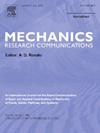Energy transport in a free Euler–Bernoulli beam in terms of Schrödinger’s wave function
IF 2.3
4区 工程技术
Q3 MECHANICS
引用次数: 0
Abstract
The Schrödinger equation is not frequently used in the framework of the classical mechanics, though historically this equation was derived as a simplified equation, which is equivalent to the classical Germain-Lagrange dynamic plate equation. The question concerning the exact meaning of this equivalence is still discussed in the modern literature. In this note, we consider the one-dimensional case, where the Germain-Lagrange equation reduces to the Euler–Bernoulli equation, which is used in the classical theory of a beam. We establish a one-to-one correspondence between the set of all solutions (i.e., wave functions ) of the 1D time-dependent Schrödinger equation for a free particle with arbitrary complex initial values and the set of ordered pairs of quantities (the linear strain measure and the particle velocity), which characterize solutions of the beam equation with arbitrary real initial values. Thus, the dynamics of a free infinite Euler–Bernoulli beam can be described by the Schrödinger equation for a free particle and vice versa. Finally, we show that for two corresponding solutions and the mechanical energy density calculated for propagates in the beam exactly in the same way as the probability density calculated for .
用Schrödinger波函数表示的自由欧拉-伯努利光束中的能量输运
Schrödinger方程在经典力学的框架中并不经常使用,尽管历史上这个方程是作为一个简化方程推导出来的,它相当于经典的日耳曼-拉格朗日动力板方程。关于这种对等的确切含义的问题在现代文献中仍在讨论。在本注记中,我们考虑一维情况,其中日耳曼-拉格朗日方程简化为欧拉-伯努利方程,这是在经典理论中使用的束。我们建立了具有任意复数初值的自由粒子的一维时间依赖Schrödinger方程的所有解的集合(即波函数ψ)与具有任意实初值的梁方程解u的有序量对集合(线性应变测量和粒子速度)之间的一一对应关系。因此,自由无限欧拉-伯努利光束的动力学可以用自由粒子的Schrödinger方程来描述,反之亦然。最后,我们证明了对于两个对应的解u和ψ,为u计算的机械能密度在光束中传播的方式与为ψ计算的概率密度完全相同。
本文章由计算机程序翻译,如有差异,请以英文原文为准。
求助全文
约1分钟内获得全文
求助全文
来源期刊
CiteScore
4.10
自引率
4.20%
发文量
114
审稿时长
9 months
期刊介绍:
Mechanics Research Communications publishes, as rapidly as possible, peer-reviewed manuscripts of high standards but restricted length. It aims to provide:
• a fast means of communication
• an exchange of ideas among workers in mechanics
• an effective method of bringing new results quickly to the public
• an informal vehicle for the discussion
• of ideas that may still be in the formative stages
The field of Mechanics will be understood to encompass the behavior of continua, fluids, solids, particles and their mixtures. Submissions must contain a strong, novel contribution to the field of mechanics, and ideally should be focused on current issues in the field involving theoretical, experimental and/or applied research, preferably within the broad expertise encompassed by the Board of Associate Editors. Deviations from these areas should be discussed in advance with the Editor-in-Chief.

 求助内容:
求助内容: 应助结果提醒方式:
应助结果提醒方式:


